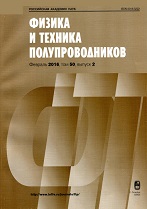|
|
Fizika i Tekhnika Poluprovodnikov, 2021, Volume 55, Issue 4, Page 355
(Mi phts6602)
|
 |
|
 |
This article is cited in 1 scientific paper (total in 1 paper)
Semiconductor physics
Performance evaluation of inversion mode and junctionless dual-material double-surrounding gate Si nanotube MOSFET for 5-nm gate length
Sanjay, B. Prasad, A. Vohra
Electronic Science Department, Kurukshetra University,
Kurukshetra-136119, Haryana, India
Abstract:
In this work, drain current $I_D$ for 5-nm gate length with dual-material (DM) double-surrounding gate (DSG) inversion mode (IM) and junctionless (JL) silicon nanotube (SiNT) MOSFET have been studied and simulation results are reported using Silvaco ATLAS 3D TCAD. For this work, we used the non-equilibrium Green’s function (NEGF) approach and self-consistent solution of Poisson’s equation with Schröodinger’s equation. The conduction band splitting into multiple sub-bands has been considered and there is no doping in channel in case of IM SiNT MOSFET. The effect of DM gate engineering for SiNT channel radius 1.5 nm with 0.8-nm gate oxide (SiO$_2$) thickness on ID has been studied. A comparison of results has been done between IM DM DSG and JL DM DSG CGAA SiNT. In case of JL, doping concentration is optimized for two concerns: (i) to get the same $I_{\operatorname{On}}$ current as IM device and (ii) to get the same threshold voltage $V_{\operatorname{Th}}$ as IM. This has resulted in 10$^2$ and 10$^3$ times smaller $I_{\operatorname{Off}}$ in matching $I_{\operatorname{On}}$ and $V_{\operatorname{Th}}$ optimized device, respectively, as compared to IM. It is found that DM gate engineering reduces drain-induced barrier lowering (DIBL) for both IM and JL SiNT MOSFET. In this work, JL have much smaller DIBL $\sim$15 mV/V, almost an ideal SS $\sim$60 mV/dec, and higher $I_{\operatorname{On}}/I_{\operatorname{Off}}$ ratio $\sim$2.18 $\cdot$ 10$^8$ as compared to available CGAA literature results.
Keywords:
inversion mode, junctionless, DM DSG, Si nanotube MOSFET, NEGF, $I_D$, SS, DIBL.
Received: 27.10.2020
Revised: 07.12.2020
Accepted: 09.12.2020
Citation:
Sanjay, B. Prasad, A. Vohra, “Performance evaluation of inversion mode and junctionless dual-material double-surrounding gate Si nanotube MOSFET for 5-nm gate length”, Fizika i Tekhnika Poluprovodnikov, 55:4 (2021), 355; Semiconductors, 55:12 (2021), 936–942
Linking options:
https://www.mathnet.ru/eng/phts6602 https://www.mathnet.ru/eng/phts/v55/i4/p355
|


|





 Contact us:
Contact us: Terms of Use
Terms of Use
 Registration to the website
Registration to the website Logotypes
Logotypes








 Citation in format
Citation in format 
